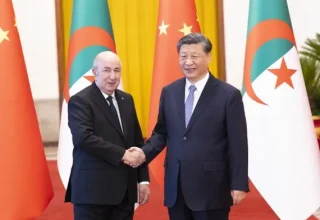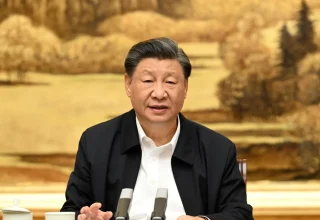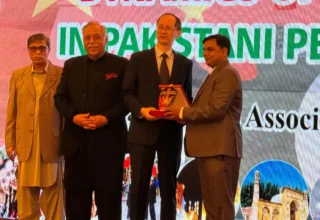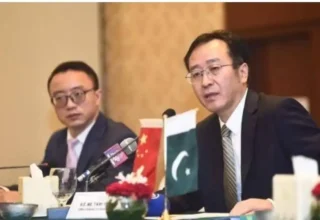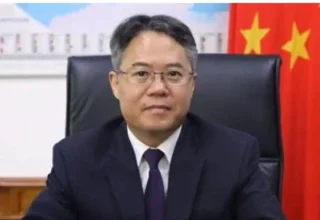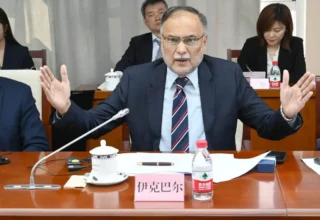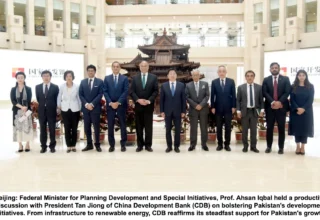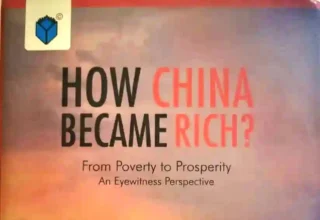
The renowned sinologist and former ambassador Syed Hasan Javed unveils the successful journey of China’s poverty alleviation campaign with Chinese characteristics that have uplifted more than 800 million people out of poverty and set an example for international community as well that is facing the same kind of challenge of poverty.
The book “How China Became Rich? From Poverty to Prosperity” authored by Syed Hasan Javed shares the vivid reflection of China’s most celebrated campaign against poverty that have gained the attention of international community and huge applause.
The book narrates various policies adopted in China in a campaign against poverty and the phases that paved the way forward for Chinese government and nation to gain the desired results that have not only eased the lives of millions in China but also generated the hope for millions across the globe that the fight against poverty can be successful as it is a very famous saying that “To be born poor is natural, but to remain poor is against the law of the nature.”
The chapter one of the book narrates the historical context and Chinese characteristics about the campaign against poverty and exploitation by imperial and colonial powers (1750-1949) by describing that China is an ancient civilization state which is blessed with a historical heritage of thousands of years and a common language.
It carries the example of an emperor Yao that have once said “if there was one person starving, it is me responsible, if one died in freezing cold, it is me responsible, if there is one criminal, it is me responsible”.
It showed that emperors in ancient China had focused on poverty alleviation and there was no comprise for even a single life dying because of hunger.
Chapter Two of the book explains that land reform rolled out (1949-1979) across the country, abolishing the feudal land system that had endured for over 2,000 years. This removed the major institutional obstacle to eliminating poverty. Socialist transformation was carried out in agriculture, individual craft industries, capitalist industry and commerce. The establishment of the socialist system provided a basic institutional guarantee for addressing the root cause of poverty.
Chapter three highlights the eight phases of China’s poverty alleviation program that have beautifully summed up the journey and struggle of Chinese nation which helped them to win the battle against poverty.
First phase (1949-1957) was the time period when Communist Party of China, inspired by the Soviet model adopted the Marxist Leninist principles of the centrally planned economy model, with state ownership of the means of production, consumption and production.
Second phase (1957-1966) describes the key features of the centrally planned economy in China since 1949 were: introduction of agriculture commune and industrial collectives, investment in social sector including the promotion of heavy industries.
Third phase (1966-1979) tells that these were the years when China’s third five-year plan was adopted. This tentative plan elaborated those measures will be taken to support agriculture and strengthen national defense, to enhance infrastructure, continue to improve production quality, increase production variety and quantity, to build an economy of self-reliance and to develop transportation, commerce, culture, education and scientific research.
Fourth phase (1979-1986) communicates that China’s poverty alleviation is unique in many respects. First it was able to halve its rural poverty in seven years from 1979 to 1986, even without calling it poverty alleviation program.
Fifth phase (1986-1993) states that following the farmers in China’s countryside became sufficiently rich, by virtue of agriculture reforms, in the first phase, they started forming small businesses. These enterprises were formally or informally sponsored by local collectives.
Sixth phase (1993-2000) describes that China’s success is courtesy of a hundred factors but amongst all these following deserve particular mention that includes dedicated collective leadership, mindset change, civil service reforms, mobilization of overseas Chinese, development of Special Economic Zones (SEZs), promotion of export culture, focus on small and medium enterprises, investment in human capital, learning from global practices and simplification of rules and procedures.
Seventh phase (2000-2010) sheds light on the factor that China has become the first country to banish poverty in human history. Poverty was stated to be officially “zero’ in 2020.
Eighth phase (2010-2020) generates a message that China’s experience shows that wealth creation and poverty alleviation cannot be separated from the development and growth trajectory of any society. In China , a nationwide initiative in order to alleviate the remaining seventy millions souls living in poverty in far flung areas, went on since president Xi Jinping announced at the 2015 Global Poverty Reduction Development Forum that the country will uplift all people living below China’s current poverty line, out of poverty.
One of the chapters of the book pens down the importance of China Pakistan Economic Corridor that is the flagship project of Belt and Road Initiative (BRI) by describing that this is the human and citizen centric initiative to uplift the welfare of Pakistanis, devoid of market connectivity by creating more or less 2,50,000 job opportunities that is planned to reach to 2 million. CPEC would roughly provide a sustainable livelihood to almost half of Pakistan’s youth entering the job market in next 10 years. So, the well-researched potential and impact of CPEC is that it has the full ability and capacity to overcome the poverty challenge in the country.
With it’s trusted, all weather strategic partner China rising on the global stage, Pakistan sits on the cusp of a new era, best positioned to undertake comprehensive reforms, harnessing the lessons from China’s poverty alleviation.
The book is a manifestation that China’s poverty reduction strategy however followed a methodical and scientific approach that included setting poverty reduction goals, registration of poverty stricken population , implementation of targeted poverty alleviation strategy , establishment of a seven tier institutional systems including accountability , policy-making, funding, social mobilization, multipronged supervision, inspection and audit and deputation of relevant officials to work in poverty stricken areas.
On the macroeconomic level, China took full advantage of opportunities made available by globalization, industrialization, hybridization and digitalization to harness its advantages in human capital to become the 2nd largest economy of the world.

